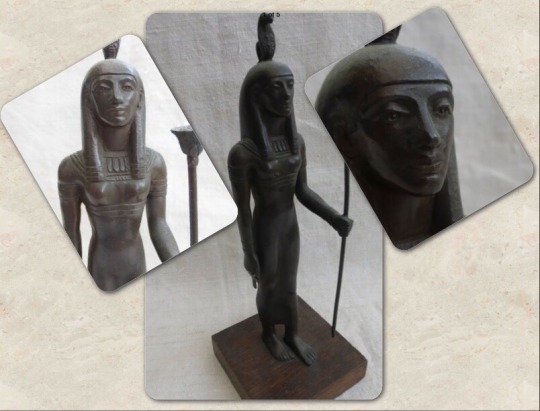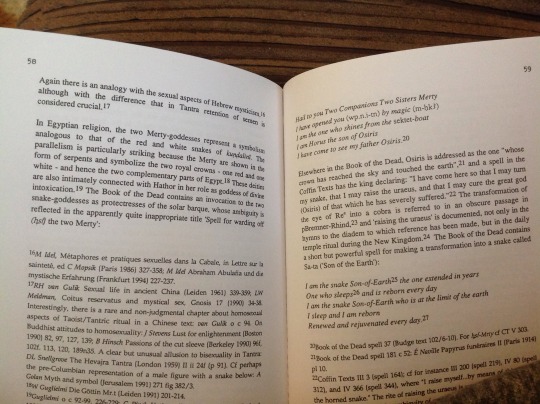#gnwt Meret
Text

(Seller’s photos)
I found this stunning beauty on eBay and am really pleased to have been the only bidder. I think she will stand in my shrine as Meret, who is demonstrably a cobra goddess and who is, for me, the uraeus that protects and accompanies Wepwawet. As a Goddess, she seems to represent a meeting point between Hathor and Ma’at in her associations and theology - a fitting companion for Wepwawet.
21 notes
·
View notes
Text
Records of Meret
Once upon a time, I bought and started trying to translate “Die Göttin Mr.T: Entstehung und Verehrung einer Personifikation”, the monograph about the goddess Meret by Guglielmi. I had gotten The Ping from her after reading a few comments about her in one of TDuQ’s articles (“Raising the serpent power. Some parallels between Egyptian religion and Indian Tantra.”) I’ve never lost interest in learning more about this beautiful but obscure goddess, but have lost the ability to gather the intense amount of concentration needed to do extended translations of that nature. To those ends, I am going to try approaching my research into her from a different angle, which is basically by flipping through the monograph’s indexes until something catches my eye and then working on that individual thing. The first entry for #gnwt Meret is this intriguing epithet for her: TpH.t-wdj.t-k3.w
The LGG has it as meaning, “The esophagus of the gods”, and specifies that it is an epithet of the Upper Egyptian Meret. Just below this entry is a very similar one listing Ma’at as the esophagus of the goddesses while Guglielmi gives a more literal translation: “Cave that transfers the Ka-food to the gods (esophagus.)” There is also a footnote: “TpH.t-wdj.t-k3.w belongs to the “throat" designations of Meret assimilated to Maat and also forms an epithet of the Hathor assimilated to Maat.”
15 notes
·
View notes
Text
More bits and pieces on Meret:
“Nurturing the vital life of the solar god, Maat manifests in the nutritive throat region when food offerings are brought. So, when bringing the god offerings, the king invokes the goddess who assists the ingestion of food:
‘Receive maat so that you may satisfy your heart,
This is your Meret-goddess who does not leave you,
The throat is before you every day so that you may live from her.’
As a songstress, the goddess Meret has associations with Hathor, who restores order through music; each of the Meret goddesses carries an epithet meaning “Mistress of the Throat,” written with two different Egyptian words for “throat”: aSaS and Hty.t. Meret also became identified with Ma’at, who was considered the throat of the god through which he obtains air and food--the sustenance of life. Furthermore, because the words mr.t (singer), mr.t (another word for throat), and MAa.t (Ma’at) probably had similar pronunciation at this time, they form an effective pun. Wilson notes that they seem to be interchangeable and are more powerful because one word incorporates the aspects of the other two... The play on the close homophones of MAa.t and mr.t, and the turn of meaning (the offering, the name of the goddess, and “throat”), emphasize the equivalencies of the concepts.” (Richter, ‘The Theology of Hathor of Dendera’ (dissertation), pp.156-157)
[Following a chart showing the various different spellings for the Uraeii/ Eyes found at Dendera]: “The mr.ty-Eyes (whose singular form can also denote the Eye of Tefnut and thus the Wandering Goddess) connect with the Meret-goddesses, as attested by the use of Meret's image for the phonogram, mr. The close homophones of Mr.t, "singer," mr.t, "throat," and MAa.t, "Ma'at," with their intertwining of connotations, allow mr.ty to allude to the restoration of cosmic order by means of the fiery uraeii, who strike down the king's enemies.” (Richter, ‘The Theology of Hathor of Dendera’ (dissertation), p.242)
“As early as the Middle Kingdom there have been other etymologization attempts. The derivation of mry “love" in the "Myth of the 'Girlfriends' of Re" with the goddesses referred to as mr(r)w.ty takes the form from a folk etymology, presumably because the original meaning of the name of the bird-divinities**, which can perhaps be regarded as the demonic aspect of the mr.t goddesses, wasn't more common. A similar derivation attempt underlies a spelling in Medinet Habu, where twice there is a pun on the nickname of Ramses III. It was sought to connect mry-rA with the goddess written mrr.t [U7:D21 - D21:X1 - C180]. Some modern academic explanations likewise went with mry “love”, such as H. Jacobsohn “the little love-goddess mr.t” and W. Helck (86) “beloved.” They are, however, not convincing.” (Gugliemi, ‘Die Göttin Mr.T’, p.15) [My translation.]
**Some explanation of the reference to the Meret/‘Meryt’ goddesses as “Bird Divinities” here, and as associated with this line of mythology, can be found in the footnotes for CT440 in Faulkner. It reads: “Mrwty here is not the word for 'well-beloved', since that interpretation would be entirely inappropriate in 294a (but see 298a), 297a, 301a and 302a. In 297e mrwty is determined with a pair of birds, and is in fact regularly construed as a dual. It is possible that it may be the original form of mrwytt, quoted in Wb. II, 104.15 as an epithet of Sakhmet, in which case it may well carry a connotation of something to be dreaded. (Faulkner, Coffin Texts vol.II, p.77)
Gugliemi’s reservations about the root of Meret’s name being found in mry aside, I personally really like this bit of folk etymology and feel it well suits a goddess whose others role include acclaiming the king and the standards of the gods, as well as acting as a divinized receiver of their bounty and blessings. The idea of the “girlfriends” of the sun-god being aggressively protective does not seem all that out of place either for a goddess who is more usually conceived of as a uraeus. It also mirrors the role of Aset and Nebthet as kites who protect and guard Wesir, and with whom the Merety can be identified. For a bit more on this “demonic” aspect of Meret, it’s worth stopping by the Henadology entry for her.
12 notes
·
View notes
Photo

Little tidbit about the goddess(es) Meret / Merty as protectresses for @mystic-scarab Meret is just the most awesome goddess. :P From an article by T. DuQuesne in Hermes Aegyptiacus DES2
11 notes
·
View notes